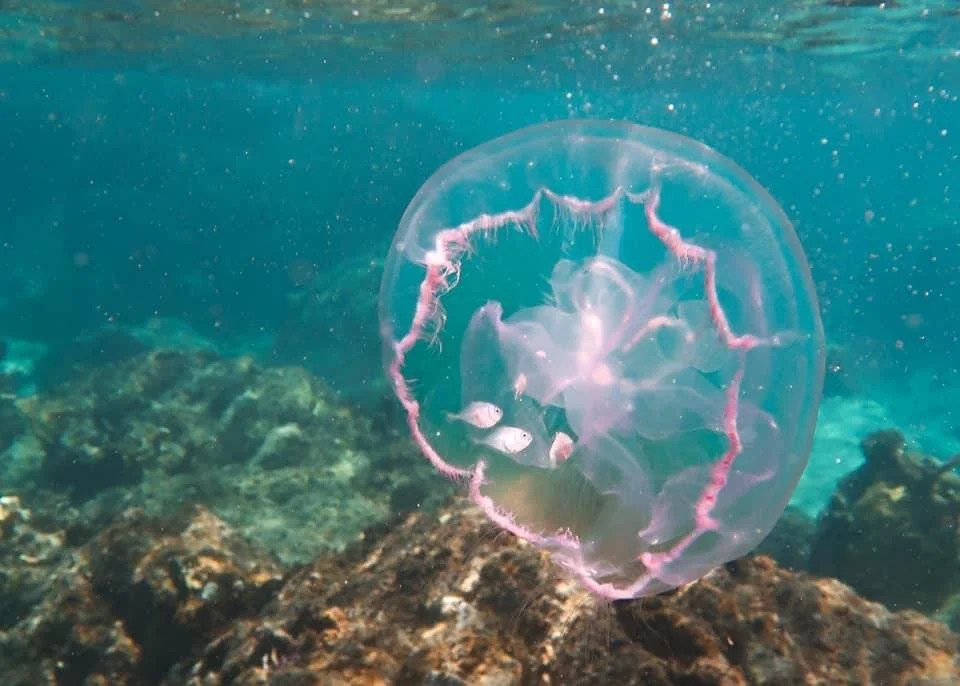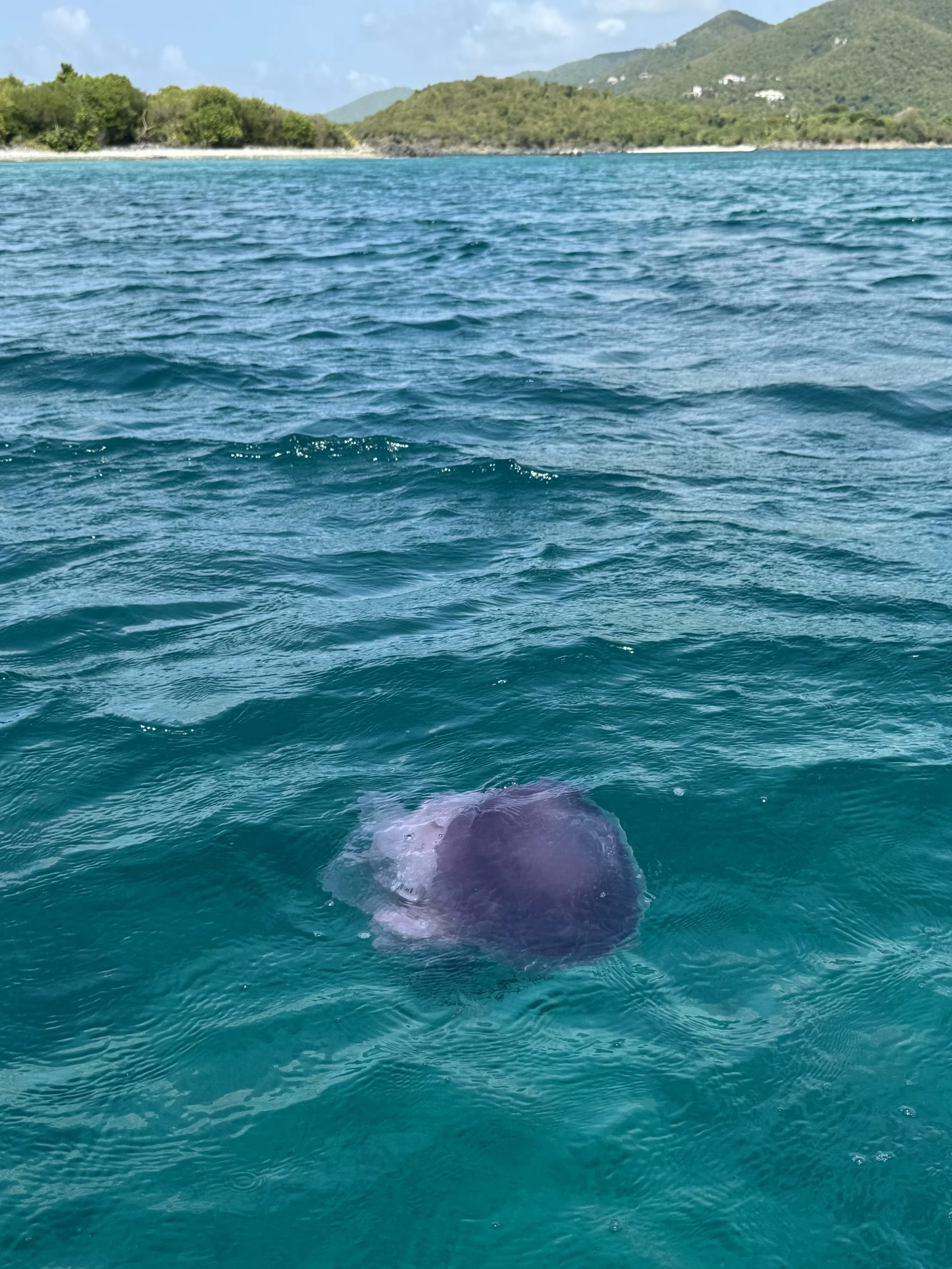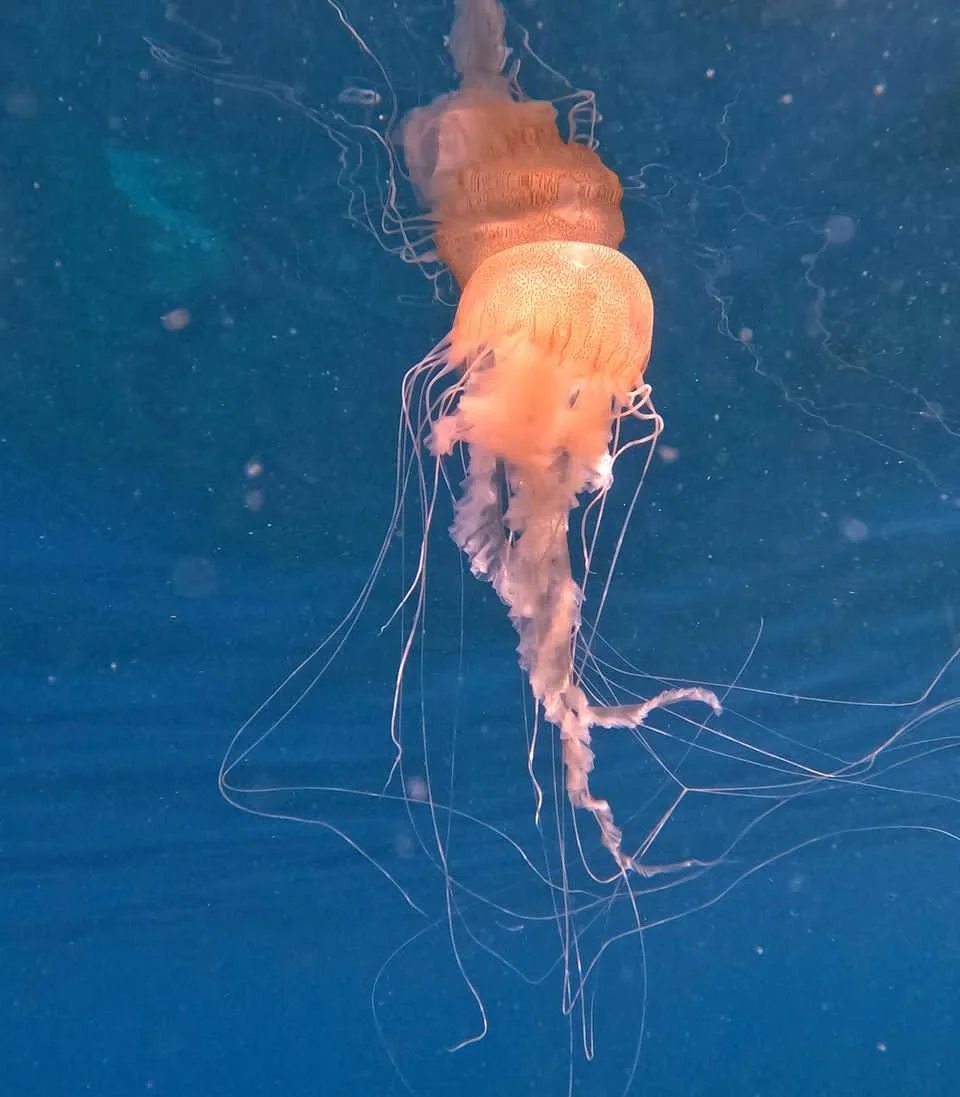Jellyfish In The Virgin Islands
Jellyfish Report 2025 – St. John, U.S. Virgin Islands
By Captain Ryan
Wow, what a summer it’s been for jellyfish blooms! I find jellyfish quite beautiful, and they are generally harmless if you simply swim around them. Although the swarms of jellies have been exceptionally thick this summer (2025), very few of our charter boat guests have actually been stung. With proper awareness of your surroundings, it’s easy to avoid jellyfish stings.
During the polyp stage, jellyfish are able to persist in a dormant state far longer than in the medusa stage, awaiting favorable environmental conditions to mature. Environmental triggers include temperature, salinity, food availability, and the presence of certain minerals.
The two species we’ve encountered most often this summer — during our charter boat tours that depart from St. John and explore the waters of the USVI and BVI — are Moon Jellies and “Pink Meanies.” Last summer, we had no Pink Meanies, but there was an abundance of Atlantic Sea Nettles. I’ll also mention the presence of Comb Jellies (Ctenophora spp.), which are translucent and very jellyfish-like, but they do not have nematocysts (stinging cells).
Moon Jellyfish (Aurelia aurita)
Moon Jellies are pinkish to purplish and have a signature four-leaf clover insignia on top of the bell. Their tentacles come down from the rim of the bell rather than from the middle of the underside and are 1–2 inches in length. I liken the Moon Jelly sting to little more than a no-see-um bite, or slightly less than a horsefly bite.
Moon Jellyfish Image- Credit, Island Roots Charters
Pink meanies (Drymonema larsoni)
Pink Meanies are thought to be slightly more painful when they sting. The sting usually feels like a “zap” on contact, similar to a sweat bee or slightly less than a honeybee. Adult tentacles can reach almost 40 feet in length and may scatter in all directions like frizzy hair. It’s best to give these jellyfish plenty of room while swimming.
Pink Meanie Jellyfish Photo - Credit, Island Roots Charters
Atlantic Sea Nettles (Chrysaora quinquecirrha)
Atlantic sea nettles and box jellyfish (a non-lethal, much milder cousin of the Australian box jellyfish) have been known to be carried into our waters from strong storms out in open ocean. Also, tiny siphonophores can sometimes float around. if you feel a mild sting, and you can’t find anything as you look around, it’s quite possibly a siphonophore species.
Atlantic Sea Nettle Jellyfish Photo - Credit, Island Roots Charters
Jellyfish First Aid
To treat jellyfish stings, Dr. Cheryl Ames, widely recognized as one of the world’s leading experts on jellyfish, particularly box jellyfish (Cubozoans), says, “do not scrape the affected area with any object to remove the tentacle from the skin. Instead dump vinegar or hot seawater directly on to cause the tentacle to pull away from the skin. Never touch a jellyfish tentacle with your hand or any object, especially if on a human.”
Typical first aid for jellyfish stings includes:
Irrigate with seawater. Avoid freshwater, as it can “shock” remaining nematocysts and cause them to fire.
Vinegar can neutralize some jellyfish venoms, though individual responses may vary.
Heat is highly effective; applying a hot compress or soak can help to quickly break down marine toxins.
— Report concluded, by Captain Ryan
Island Roots Charters — First Aid Preparedness For Jellyfish Stings
If a guest is stung by a jellyfish while on an Island Roots Charter trip — which is rare (about 1 in 100, or 1%) — we act quickly to apply the above first aid treatment.
*For context, Captain Ryan has only had two jellyfish stings in 2025. One of them occurred jumping off the Willy-T (off of Norman Island in the BVI waters) right into a jellyfish (what are the chances?!) and the other sting occurred during snorkeling. Island Roots Charters has never had to cancel a charter trip because of a serious jellyfish sting.
No Man-O-War Or Box Jellyfish Sightings or Stings In Virgin Islands Observed By Island Roots Charters
Island Roots Charters has never encountered a box jellyfish or Portuguese man-of-war in the part of the Caribbean Sea where the Virgin Islands are located. While this doesn’t mean they aren’t present, their extreme rarity is clear—tens of thousands of guests on thousands of charter trips have never seen either of these more dangerous jellyfish near St. John, USVI.
Are there jellyfish in the Caribbean?
Yes, the Caribbean Sea hosts a variety of jellyfish species. Common types include: Moon Jellyfish (Aurelia aurita), Pink Meanie Jellyfish (Drymonema larsoni), Atlantic Sea Nettle (Chrysaora quinquecirrha), Comb Jellies (Ctenophora spp.), Caribbean Box Jellyfish (Tripedalia / Carybdea spp.), and colonies of Portuguese man-of-war (Physalia physalis).
Are there box jellyfish in the Caribbean?
There are different kinds of box jellyfish that inhabit the Caribbean Sea, but they are less dangerous than the Australian box jellyfish.
Dr. Cheryl Ames has provided information on the different types of box jellyfish, which is compiled into the table below:
| Region | Severity | Species / Genus | Bell Size | Tentacles |
|---|---|---|---|---|
| Australia | Deadly – Highly dangerous box jellyfish | Chironex fleckeri | Up to 50 cm | ~50; over 2 m |
| Australia | Associated with Irukandji syndrome | Carukia (genus) | Small | 4 |
| Australia | Associated with Irukandji syndrome | Malo (genus) | Medium | 4 |
| Australia & Caribbean | Associated with Irukandji syndrome | Alatina alata | Up to 20 cm | 4 |
| Australia | Mild–medium sting | Carybdea (genus) | Up to 10 cm | 4; up to 80 cm |
| Caribbean | Highly venomous (no reported fatalities) | Tamoya ohboya | Up to 25 cm | 4 (striped) |
| Caribbean | Mild–medium sting | Carybdea (genus) | Up to 10 cm | 4; up to 80 cm |
Why are Caribbean box jellyfish less deadly than Australian box jellyfish?
“The reason behind Australia having the most deadly box jellyfish (Chironex fleckeri) may be due to the Australian continent’s long geological isolation since around 180 million years ago with the breakdown of Gondwana (formed in the Precambrian around 600 mya). The much smaller Caribbean islands formed more recently (130 mya), from volcanic activity, in scattered formations. No major reef like the Great Barrier Reef remains, so despite plenty of venomous animals, perhaps comparatively, jellyfishes didn’t need to evolve to be outright deadly to mammals.
Experts on terrestrial venomous animals such as snakes state that venomous animals evolved earlier in Australia due to evolutionary pressures and co-evolution with other dangerous and venomous animals (e.g., crocodiles and elapid snakes). The same is likely true for coastal marine habitats where competition is high and top predators are abundant,” explains Dr. Ames.
When is jellyfish season in the Caribbean?
General jellyfish season in the Caribbean is from summer through early fall (June to September), but some, like the Man‑o‑War, can appear year-round, though they are more frequent in warmer months.
When is box jellyfish season in the Caribbean?
Box jellyfish in the Caribbean are most commonly seen in summer months.
What do jellyfish eat?
Mostly plankton, tiny fish, and other small organisms. Pink Meanies also feed on other jellyfish.
Do jellyfish have brains?
No; they have nerve nets instead of a central brain.
How do jellyfish reproduce?
They alternate between polyp (asexual) and medusa (sexual) stages.
Do jellyfish have eyes?
Some species have light-sensitive organs or rudimentary eyes. Dr. Ames notes that, “about 50 species of box jellyfish exist worldwide, mainly in tropical to subtropical marine ecosystems. All have separate male and female organ-like structures and functional eyeballs that can capture an image on the retina. A study showed that the Australian Chironex fleckeri can avoid obstacles while swimming.”
How long do jellyfish live?
Most jellyfish life cycles range from a few hours to several years depending on species. Unlike most jellyfish, which have a set and usually short lifespan, the immortal jellyfish can revert its adult (medusa) stage back to its juvenile polyp stage under stress or injury.
Reference Chart (Below) for The Types Of Caribbean Jellyfish Floating Around The Virgin Islands (USVI & BVI)
| Common Name | Scientific Name | Sting Level (1–10) | Season | Notes |
|---|---|---|---|---|
| Moon Jellyfish | Aurelia aurita | 1–2 | Summer | Very mild; usually just slight redness or itch |
| Pink Meanie Jellyfish | Drymonema larsoni | 4 | Late Summer | Moderate “zap”; noticeable but not severe |
| Atlantic Sea Nettle | Chrysaora quinquecirrha | 5–6 | Summer–Fall | Moderate sting; can cause rash or welts |
| Comb Jelly | Ctenophora spp. | 0 | Year‑round | Harmless; no stinging cells |
| Caribbean Box Jellyfish | Tripedalia / Carybdea spp. | 7–8 | Rare - Summer, blown in from big storms | Intense burning, welts, throbbing; seek medical care if severe |
| Siphonophores (e.g., Man‑o‑War) | Various Hydrozoa | 8–9 | Rarely, if ever seen in USVI / BVI | Very painful; serious stings need medical attention |



